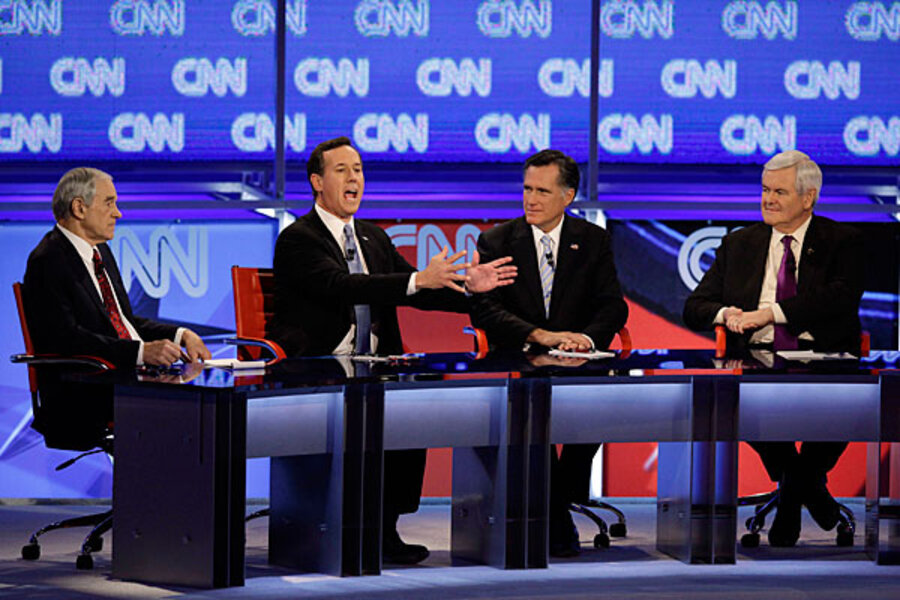Media report card: why Mitt Romney got more positive coverage than Obama
Loading...
A media report card from the Pew Research Center’s Project for Excellence in Journalism released Monday included a few surprises, as well as a message about the pervasiveness of the media and their power in shaping the public’s perception of the political process.
The Project analyzed the tone and volume of candidate coverage from Jan. 2 through April 15 focusing on 52 key news outlets, but also using computers to track coverage in more than 11,000 news outlets. The team also looked at campaign stories from November through April 15.
That window, however, turned out to be too short. “One of the most remarkable and perhaps depressing things about modern political coverage is how early it starts,” says PEJ Director Tom Rosenstiel. As early as August 2011, “We were seeing almost weekly polling.”
On one hand, that shows a media industry engaged in the political process. But the sheer volume and constancy of the reporting is turning politics into a form of white noise for many Americans, says Charles Dunn, a political scientist at Regent University in Virginia Beach, Va.
“People are exhausted and overwhelmed by the amount of information,” especially at such early stages of the game, he says. By the time the actual election rolls around in November, many average Americans just want it to be over, he says, “and this does not bode well for the body politic where we need more not less engagement by the voters.”
On the upside, the type of media campaign coverage saw a positive change from 2008 to 2012. In 2008, some 80 percent of the media coverage was devoted to the primary horse races, but that number shrank to some 64 percent in this cycle, says Mr. Rosenstiel.
"There was a perception back in 2008 that there was not that much difference between the Democratic candidates," he says. In this race, there was much more media effort devoted to defining the various candidates based on their stands on certain issues. For Republican front-runner Mitt Romney, for example, the media examined his health-care position, as well as “whether or not he is a true conservative,” Rosenstiel says.
The report also charted the character of coverage of the candidates. Coverage of President Obama was far more negative than the coverage of Mr. Romney, for whom the tone was more mixed, says Rosenstiel.
"There is a certain logic to the math in this,” he says, noting that all the Republican candidates focused much of their fire on Mr. Obama. “If you have some seven different individuals all getting coverage from the media, all framing their arguments negatively against the president," that will inevitably create an imbalance.
"President Obama only has a single voice to counter that flood of critiques," he adds.
Other key observations include:
- Romney’s personal life and public record were vetted more than any candidate – constituting some 12 percent of his coverage, with Newt Gingrich nearly tied. The focus on Romney’s life centered on his personal wealth and his career at the private equity investment firm Bain Capital, while Mr. Gingrich gathered much attention for his marital history and financial dealings.
- Rick Santorum, who emerged as Romney’s chief rival, never received sustained positive press. He had three brief periods in which his coverage was more positive than negative – following his strong showing in Iowa; his victories in Missouri, Colorado and Minnesota; and the week of his win in Louisiana.
- Gingrich had only one week during the primary season in which he enjoyed significantly more positive press coverage than negative. That was the week of his victory in South Carolina on Jan. 21.
- In 11 of 15 weeks studied, Rep. Ron Paul (R) of Texas received more positive coverage than negative – but he received less coverage than other candidates. Congressman Paul received about one-eighth as much coverage as Romney and about one-quarter as much as Mr. Santorum and Gingrich.
What this report spotlights is the punch of the permanent news cycle, says Villanova University political scientist Matt Kerbel. "This becomes important because the way the press frames the ongoing story has very much to do with what people think the election is about."





